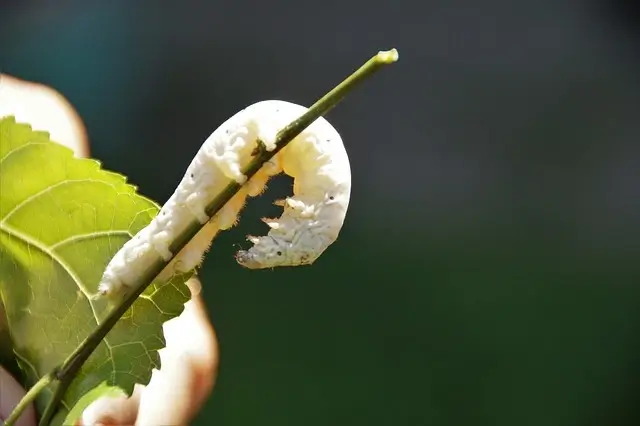Introduction
Silkworms are the caterpillar larvae of the domestic silk moth, Bombyx mori. They are a source of silk, a material prized for its strength, softness, and shine. Silkworms feed on mulberry leaves, and in the wild, can be found in the forests of China, India, and other parts of Asia. Silkworms are easy to care and rearing of them is done at a big scale for the production of silk. Thus, it is a popular business in countries like China, India, Brazil, etc.
Housing of Silkworms
Silkworm rearing is a process in which silkworms are kept in an environment that is conducive to their growth and development. This includes providing food, water, temperature, and humidity levels that are ideal for their health and growth. Silkworms are typically housed in cages or trays that are lined with paper or cloth, and these can be kept in a variety of environments, such as indoors or outdoors.
Additionally, the rearing environment should be clean and free of any potential contaminants, such as dust, bacteria, and mold. Additionally, silkworms must be monitored for signs of disease or parasites and given proper care. Silkworms are easy to care for if kept with appropriate care and living conditions.
Feeding silkworm
Feeding silkworms involves providing them with mulberry leaves. The leaves should be fresh, young, and free from pesticides, herbicides, and other contaminants. Silkworms should be fed twice a day, in the morning and evening, and the leaves should be replaced with fresh ones every other day. The number of leaves given at each feeding should be enough to cover the bottom of the container. The leaves should be chopped or stripped into small pieces to make it easier for the silkworms to consume them.
Setting up habitat
We need a covered airtight container for setting up the living space to raise silkworms. They don’t need extra water to drink because they get the needed moisture from their diet or the food they take. The airtight container with small holes will prevent food from getting to dry up and allow air to exchange. 78 to 88 degrees F is the suitable temperature for keeping the silkworms. They feed 24 hours so food must be available for them every time.
Breeding of Silkworms
The process of inbreeding silkworms involves crossbreeding two silkworms with close genetic relations, such as siblings, to produce a silkworm with a specific set of desired traits. Inbreeding is primarily done to increase the production of desirable traits in the offspring. The process involves selecting two silkworms with desirable traits and mating them, usually through artificial insemination, to produce offspring.
The offspring should be monitored for any changes in their traits and genetic makeup. If the desired traits are seen in the offspring, the process can continue with more inbreeding to further refine the desired traits.
Inbreeding should only be done for a limited number of generations to avoid inbreeding depression, which is when the silkworms become less fit and have reduced fertility.
Everything about silkworm eggs
-
How many eggs does a female lay?
Each female lays approx. 200 to 500 eggs which are of golden to yellow color. You have to put a piece of paper in the bottom of the container on which silkworms will lay eggs. After the moths will emerge you have to remove empty cocoons from the container.
-
How can detect the fertility of the eggs?
In the initial stages, eggs have lemon-yellow color. After three days, we can detect if the eggs are fertile or not by their color. The eggs that will turn white are infertile and if they turn black after 3 days that means they are fertile. In summer eggs usually hatch about two weeks after they are laid down. This time can vary in winter.
-
Storing eggs
If you want to put them in the refrigerator in a Ziplock bag, wait till the eggs turn black. After taking them out from the fridge they will take 7 to 20 days for hatching. Additionally, direct sunlight for a few hours in the morning will speed up the hatching process of eggs.
Conclusion
Every being needs care and the correct habitat to live in. Silkworms are the worms used to make silk widely. They feed on mulberry leaves, and only its leaves or mulberry chow are made from fresh and processed mulberry leaves. Mostly the chows are used to raise silkworms at a larger scale. They are easy to raise with some care during the whole rearing process.


Raising silkworms is a wonderful way to get hands-on with silk production at home. Keeping the environment clean, feeding them fresh mulberry leaves, and maintaining the right temperature and humidity are crucial. It’s a bit of a labor of love, but seeing them grow and produce silk is so rewarding!
Hey, I’m Kevin. Silkworms are such an interesting creature to cultivate! Providing them with a suitable habitat, proper feeding, and regular care is key to their growth and successful silk production. I find it fascinating how their entire life cycle is interconnected with the environment and their food source.
Hello I’m Hredhaan. Raising silkworms can be a fascinating and rewarding experience! They require a clean, controlled environment with optimal temperature and humidity, and fresh mulberry leaves are crucial for their diet. Monitoring their health and promptly addressing any signs of disease or parasites is essential. Proper care ensures the silkworms grow well and produce quality silk. Have any tips or experiences with silkworms you’d like to share?